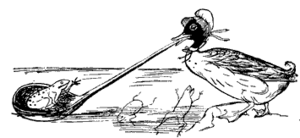- The Owl and the Pussycat
-
 Le canard Dolomphious attrapant des grenouilles tâchetées pour son dîner avec la Runcible Spoon
Le canard Dolomphious attrapant des grenouilles tâchetées pour son dîner avec la Runcible Spoon
The Owl and the Pussycat est un célèbre poème d'Edward Lear basé sur le non-sens et publié en 1871.
Sa caractéristique principale est l'utilisation de l'expression runcible spoon (en) (cuillère à long manche ? à manche coudé ?).
Sommaire
Le poème
Lear écrivit le poème pour Janet Symonds, la fille de son ami, le poète John Addington Symonds, et de sa femme Catherine.
Il met en scène quatre animaux anthropomorphes, le Hibou, la Chatte, le Porcelet et le Dindon, raconte les amours des deux premiers, leur rencontre avec le troisième et leur mariage par le quatrième.
Les petits personnages prennent la mer dans « a beautiful pea-green boat » (« un beau bateau couleur petit pois vert »). L'expression « pea-green » se retrouve plusieurs fois dans les écrits de Lear, notamment dans les journaux qui nous sont parvenus.
Le poème fait partie d'une série inachevée : The Children of the Owl and the Pussycat, publiée de manière posthume en 1938.
Adaptations
L'histoire a été mise en musique à maintes reprises, notamment par Igor Stravinski et Laurie Anderson et a fait l'objet de nombreux films d'animation :
- 1948 : version composée par Elton Hayes (en) et enregistrée en 1953 par Parlophone. Elle devint un succès de l'émission de la BBC Radio, Children's Favourites (en).
- 1952 : cartoon d'Halas et Batchelor.
- 1966 : mise en musique par Igor Stravinski. Un enregistrement est réalisé sous la supervision du compositeur par Sony.
- 1968 : thème central d'une comédie musicale pour enfants, autour des nonsense poems de Lear, écrite par Sheila Ruskin et David Wood et intitulée The Owl and the Pussycat went to sea (Le Hibou et la Petite Chatte sont partis en mer).
- 1968 : dans le film d'animation de la Disney Company Winnie the Pooh and the Blustery Day repris en 1977 dans The Many Adventures of Winnie the Pooh, le personnage de Maître Hibou mentionne l'un de ses parents supposé « avoir avoir été en mer dans un bateau couleur petit pois vert » (« went to sea in a pea-green boat ») avec une Pussycat.
- 1968 : Les deux personnages principaux ont inspiré X the Owl et Henrietta Pussycat dans le Neighborhood of Make-Believe (en) de Mister Rogers' Neighborhood (en).
- 1970 : le titre est emprunté pour une pièce de théâtre puis pour un film avec Barbra Streisand and George Segal sans rapport avec le poème.
- 1971 : cartoon basé sur le poème réalisé par Weston Woods (en).
- 1994 : Laurie Anderson compose et enregistre une version titrée Beautiful Pea Green Boat intégrée dans l'album Bright Red (en).
- 1996 : Eric Idle, membre des Monty Python's Flying Circus, écrit un livre pour enfants basé sur le poème et intitulé The Quite Remarkable Adventures of the Owl and the Pussycat. Il raconte une suite où le Hibou et la Petite Chatte sont attaqués par une bande de rats sans scrupules sortis voler des tartes. Illustré par Wesla Weller (en) il est publié sous forme de livre audio qui comporte des chansons de Idle.
Liens externes
- The Owl and the Pussycat, texte original
- The Children of the Owl and the Pussycat, texte original
- The Owl and the Pussycat Went to Sea, la pièce de Ruskin et Wood
- The Owl and the Pussycat, le film avec Barbra Streisand et George Segal
- The Owl and the Pussycat, traductions dans différentes langues et interprétations mises en musique, de Donovan à Igor Stravinski (premier et dernier items en haut à droite)
- Reely's Poetry Pages, version audio de The Owl and The Pussycat (Anthology of English Verse, Vol. 1)
- Audio-livre
- Autre version audio
Autres projets
- (en) The Owl and the Pussy-cat (sur Wikisource en anglais)
Source
- (en) Cet article est partiellement ou en totalité issu de l’article de Wikipédia en anglais intitulé « The Owl and the Pussycat » (voir la liste des auteurs)
Catégories :- Poème anglais
- Œuvre de littérature d'enfance et de jeunesse
Wikimedia Foundation. 2010.



